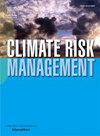评估农业的脆弱性和气候风险,以制定恒河三角洲的抗灾农业战略
IF 5
2区 环境科学与生态学
Q1 ENVIRONMENTAL SCIENCES
引用次数: 0
摘要
恒河三角洲拥有独特的沿海生态系统,极易受到全球气候变化的影响。本文介绍了一项关于气候变化对孟加拉国和印度三角洲地区沿海农业影响的研究结果。这项研究考察了风险是如何从危害、暴露和脆弱性的相互作用中产生的。利用IPCC第六次评估报告中的未来气候数据,对89个行政单位(孟加拉国的upazila和印度的block)的气候危害进行了评估。通过综合对作物生长至关重要的四种极端温度和五种极端降雨的影响,评估了危害程度。通过广泛的文献回顾,18个生物物理和社会经济变量被确定为关键的和与政策相关的变量,其中3个与暴露有关,15个与脆弱性有关。所有指标归一化为无量纲尺度,范围从0到1,用于脆弱性和风险评估。孟加拉国的三个upazilas被列为非常高的气候危害。与孟加拉国海岸相比,印度海岸的暴露得分相对较高。在分析的89个行政单位中,孟加拉国的5个区和印度的2个区被确定为非常高脆弱性指数,覆盖18.6%的面积和8.13%的总人口。在综合脆弱性和气候风险后,孟加拉国的三个农场和印度的一个街区被确定为农业面临非常高的风险。这些发现为制定可持续农业战略和应对恒河三角洲和全球其他类似沿海生态系统的气候风险提供了一个实用框架。本文章由计算机程序翻译,如有差异,请以英文原文为准。
Assessing vulnerability and climate risk to agriculture for developing resilient farming strategies in the Ganges Delta
The Ganges Delta supports a unique coastal ecosystem that is highly susceptible to global climate change. This paper presents results from a study on climate change impacts on coastal agriculture in the deltaic regions of Bangladesh and India. The study examined how risk emerges from the interaction of hazard, exposure and vulnerability. Climate hazards for the 89 administrative units (upazila in Bangladesh and block in India) were assessed using future climate data from the IPCC’s 6th assessment report. Hazard levels were assessed by integrating the impacts of four temperature extremes and five rainfall extremes critical to crop growth. Through an extensive literature review, 18 biophysical and socio-economic variables were identified as critical and policy-relevant, including three related to exposure and 15 to vulnerability. All indicators were normalized to a dimensionless scale ranging from 0 to 1 for use in vulnerability and risk assessments. Three upazilas in Bangladesh were classified as being under very high climate hazard. The exposure score was found to be relatively higher along Indian coast compared to Bangladesh coast. Among the 89 administrative units analyzed, five upazilas in Bangladesh and two blocks in India were identified under very high vulnerability index, covering 18.6% the area and 8.13% of the total population. When combining vulnerability and climate hazard, three upazilas in Bangladesh and one block in India were identified under very high risk to agriculture. These findings provide a practical framework for developing sustainable agricultural strategies and addressing climate risks in the Ganges Delta and other similar coastal ecosystems worldwide.
求助全文
通过发布文献求助,成功后即可免费获取论文全文。
去求助
来源期刊

Climate Risk Management
Earth and Planetary Sciences-Atmospheric Science
CiteScore
8.20
自引率
4.50%
发文量
76
审稿时长
30 weeks
期刊介绍:
Climate Risk Management publishes original scientific contributions, state-of-the-art reviews and reports of practical experience on the use of knowledge and information regarding the consequences of climate variability and climate change in decision and policy making on climate change responses from the near- to long-term.
The concept of climate risk management refers to activities and methods that are used by individuals, organizations, and institutions to facilitate climate-resilient decision-making. Its objective is to promote sustainable development by maximizing the beneficial impacts of climate change responses and minimizing negative impacts across the full spectrum of geographies and sectors that are potentially affected by the changing climate.
 求助内容:
求助内容: 应助结果提醒方式:
应助结果提醒方式:


